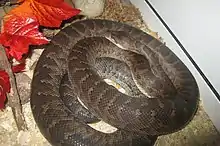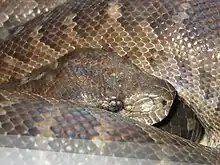Chilabothrus striatus
Chilabothrus striatus, the Hispaniolan boa, is a species of snake in the family Boidae.[3] The species is endemic to Hispaniola (split between Haiti and the Dominican Republic). The species is regularly found in the international pet trade.[1]
| Chilabothrus striatus | |
|---|---|
 | |
| A captive Chilabothrus striatus in a terrarium | |
| Scientific classification | |
| Domain: | Eukaryota |
| Kingdom: | Animalia |
| Phylum: | Chordata |
| Class: | Reptilia |
| Order: | Squamata |
| Suborder: | Serpentes |
| Family: | Boidae |
| Genus: | Chilabothrus |
| Species: | C. striatus |
| Binomial name | |
| Chilabothrus striatus (J.G. Fischer, 1856) | |
| Synonyms[2] | |
| |
Subspecies

Close-up of head of Chilabothrus striatus showing vertical pupil characteristic of the genus Chilabothrus
Three subspecies are recognized:[4]
- Chilabothrus striatus exagistus Sheplan & Schwartz, 1974 – Tiburon Peninsula boa
- Chilabothrus striatus striatus (J.G. Fischer, 1856) – Hispaniolan or Dominican red mountain boa
- Chilabothrus striatus warreni Sheplan & Schwartz, 1974 – Tortuga Island boa
Nota bene: A trinomial authority in parentheses indicates that the subspecies was originally described in a genus other than Chilabothrus.
Etymology
The subspecific name warreni is in honor of C. Rhea Warren who collected herpetological specimens on Île de la Tortue.[5]
References
- Landestoy, M.; Henderson, R.W.; Inchaustegui, S. (2018). "Chilabothrus striatus". IUCN Red List of Threatened Species. 2018: e.T62231A18979323. doi:10.2305/IUCN.UK.2018-2.RLTS.T62231A18979323.en. Retrieved 20 November 2021.
- "Chilabothrus striatus ". The Reptile Database. www.reptile-database.org.
- "Epicrates ". Integrated Taxonomic Information System. Retrieved August 11, 2010.
- Schwartz A, Thomas R (1975). A Check-list of West Indian Amphibians and Reptiles. Carnegie Museum of Natural History Special Publication No. 1. Pittsburgh, Pennsylvania: Carnegie Museum of Natural History. 216 pp. (Epicrates striatus, pp. 186-186).
- Beolens, Bo; Watkins, Michael; Grayson, Michael (2011). The Eponym Dictionary of Reptiles. Baltimore: Johns Hopkins University Press. xiii + 296 pp.
ISBN 978-1-4214-0135-5. (Epicrates striatus fowleri, p. 93; Epicrates striatus warreni, p. 280).
Further reading
- Boulenger GA (1893). Catalogue of the Snakes in the British Museum (Natural History). Volume I., Containing the Families ... Boidæ ... London: Trustees of the British Museum (Natural History). (Taylor and Francis, printers). xiii + 448 pp. + Plates I-XXVIII. (Epicrates striatus, pp. 96–97).
- Fischer JG (1856). "Neue Schlangen des Hamburgischen Naturhistorischen Museums ". Abhandlungen aus dem Gebiete der Naturwissenschaften Verein in Hamburg 3 (4): 79–116. (Homalochilus striatus, new species, pp. 102–106 + Plate II, Figures 2a & 2b). (in German).
- Sheplan BR, Schwartz A (1974). "Hispaniolan Boas of the genus Epicrates (Serpentes, Boidae) and their Antillean relationships". Annals of Carnegie Museum of Natural History 45: 57–143.
This article is issued from Wikipedia. The text is licensed under Creative Commons - Attribution - Sharealike. Additional terms may apply for the media files.
